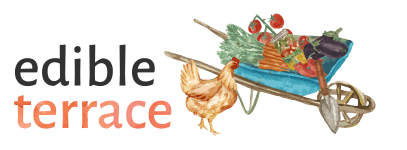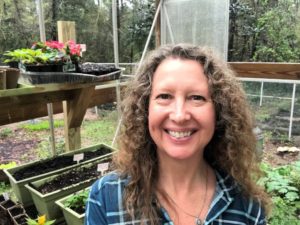Hey! By the way… TheEdibleTerrace is reader-supported. When you buy through links on our site, we may earn an affiliate commission and as an Amazon affiliate, we earn from qualifying purchases. Thanks in advance for your support!

All New Square Foot Gardening II: The Revolutionary Way to Grow More in Less Space Today, we are going to give you the basics of how to plant a square foot garden! Exciting yes?!?
Today, we are going to give you the basics of how to plant a square foot garden! Exciting yes?!?
Consuming whole food today has become a high priority today now that we understand the many benefits that can be derived from it. Vegetables and fruit are vital as they are rich in vitamins, minerals and antioxidants which not only promote good health but also protect our bodies from many deadly diseases such as cancer.
Having a square foot garden in your back yard will ensure a constant supply of fresh fruit and vegetables which will increase the health and wellness of you and your family.
What is Square Foot Gardening?
Commonly referred to as SFG, square foot gardening is a farming concept that was developed by Mel Bartholomew, an American author and TV presenter back in the 1970s. The planting method was developed to provide a simpler way of creating easy to manage gardens that required fewer resources to maintain.
In the 1980’s, the concept gained popularity especially after the founder wrote the first book and developed a TV series about it. Today, the planting method has gone mainstream and many companies today have developed ready-to assemble SFG gardens and square foot gardening planners.
The concept of Square Foot Gardening has become popular today because it uses less space, produces more harvest that is healthy and free from pesticides, and uses less soil and water.
What can you grow in a Square Foot Garden?
Most types of fruit (such as strawberries), vegetables and herbs can be grown in your Square Foot Garden. You can even grow hummingbird friendly flowers to enhance your garden’s appearance if you want. Think about it from the perspective of size. Extra-large vegetables such as cabbage or cauliflower will take up an entire square foot. Large plants like leaf lettuces or peppers are planted four to a square.
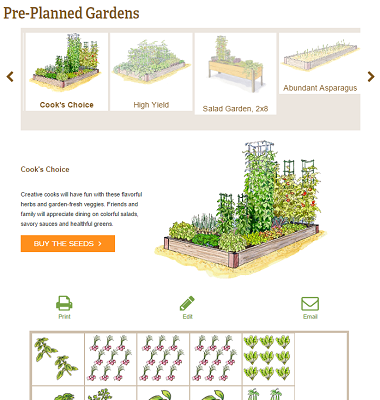
Gardeners.com Garden Planner
There are several square foot gardening planting guides out there to help you strategically plan out your garden.
- Gardener’s Supply Square Foot Garden Planner (This planner is very interactive and fun to use!)
- SFG Planner
- MySquareFootGarden.net
Depending on your state or home town, you may be able to grow and reap more produce than is listed on these websites. Do your research so you know which plants will work best with the type of soil and growing zone you live in.
The tastiest vegetables will come directly from your home vegetable garden and you can achieve this by planning and building your own. The majority of SFG gardeners can attest to square foot gardening offering maximum yield for minimal effort.
If you have been planning to develop your own square foot garden but you have hesitated due to concerns about the cost, know that SFG is a worry free and low cost vegetable gardening method. However, in order to gain the benefits of a SFG, you need to know how to plan and create it.
You can opt to purchase either this ready to assemble kit or this fabric raised garden bed from Amazon which will save you time and energy!
Greenes Fence 48-Inch x 96-Inch Cedar Raised Garden Bed Elevated Cedar Garden Bed, 48″ L x 24″ W x 31″
Elevated Cedar Garden Bed, 48″ L x 24″ W x 31″ Metal Raised Garden Bed Kit – Length: 46″ x 35″ x 12″
Metal Raised Garden Bed Kit – Length: 46″ x 35″ x 12″
Square Foot Garden Planting Guide
Requirements
- Garden area
- Soil – this will depend on the type of soil in your home area. The folks at Squarefootgardening.com suggest Mel’s mix of 1/3 vermiculite, 1/3 peat moss and 1/3 compost. Talk with your home area expert for the best solution.
- Gardening tools
- Gloves
- Passion!
How to build your own SFG – Step by Step guide
Step 1. Draw the Layout of Your Square Foot Garden Spacing
You don’t have to be an experienced artist to do this. All you need is a pencil and paper (or one of the online guides recommended above). The recommended size for your garden bed is 4 feet by 4 feet or 4 feet by 8 feet.
These measurements allow you to sub-divide your raised garden into squares that have equal measurements of one foot. This allows for enough space for the plants to grow well. Each square can be planted with seeds of your choosing.
Once you have drawn your layout, you can name the sides: North, South, East, West. If you are having challenges creating your plan, try out one of the previously listed online square foot gardening planner tools. (That’s what I do, TBH!)
Step 2. Plan What to Plant
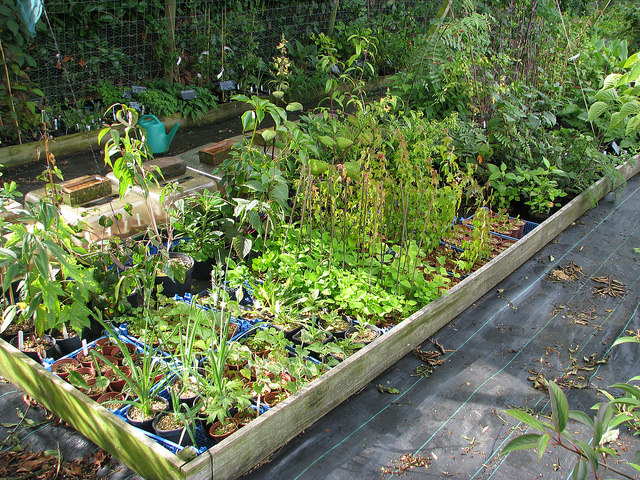
Before you start constructing your square foot garden, you need to know what to plant. The easiest vegetables to grow include lettuce, basil, green beans, green onions, snow peas, zucchini, tomatoes, cucumbers and beets.
Consider the importance of companion planting in your planning. Let’s face it; every location has different weather patterns and environment.
To ensure a good harvest, do some research and find out which plants are most suitable to grow in your area. This will give you peace of mind and lots of produce in the end. For example, I cannot grow asparagus here in No Flo. It is just too warm! In fact, the gardeners I have spoken with told me if I really felt the need to grow my own asparagus, I should move to Connecticut. Made me laugh!
Your best bet and the most efficient way to find these answers is to go talk to someone at your local nursery. I rely on them more and more as I get deeper into my gardening life.
Step 3. Purchase the Materials
The materials needed to build your own square foot garden include:
- Pressure treated lumber for the frames
- Wood screws
- Screwdriver
- Fiberglass screening
- String
- Cardboard
- Tape measure
- Small nails
You will also need time! If you love the DIY method, you can make the necessary measurements, cuts, and joinery which will give you the final product. There are several square foot garden box plans online including these for an elevated Square Foot Garden from the University of Florida.
The Food Project also offers a pdf online for creating your own raised bed-with or without a frame. The manual is very thorough-from choosing the type of framing material to framing instructions to soil vendor lists. Lots of pictures included!
Step 4. Location! Location! Location!
Every successful real estate agent will always tell you in order to buy the right house, you need to select the perfect location. In this case, as a gardener, you need to select the right spot for your garden. In order to determine the right spot, there are a few things to consider. They include:
-
- Sunlight – Plants need it in order to grow. When choosing a spot, pick one where no obstacles will create shade over your SFG. The east side of your house is the best location (west and east are second choice). You want your garden spot to get 6-8 hours of sunlight each day. In fact, spend a couple days determining this first. Go out there every couple hours to see how much sunlight your prospective locations get. This is SO important!
- Support – If you are looking forward to planting peas, cucumbers or tomatoes on your square foot garden, you need to consider support. This means that where you choose to place the support for the plants should leave room for you to access other plants.
Now that you have chosen the perfect location, you can finally build your box. If you have the materials, this should be easy and if you have an easy-to-assemble kit, it will be even easier. To avoid transporting the box from one location to another, assemble it close to your chosen location for the SFG.
One important thing you need to do is ensure that your box is lined with cardboard at the bottom. This helps to prevent weeds and chemicals from coming into contact with your raised garden which can reduce your yield as your plants will be competing with the weeds for resources.
Step 5. Fill the Bed With Soil
Depending on the type of square foot soil you have, whether it’s Mel’s mix or your own preferred mixture, fill the box with it. When filling, ensure that you have left ½ an inch from the top of the wooden box. Some people may ask why do this?
This helps to prevent soil from falling off the box when you are uprooting plants in order to harvest or plant new ones.
Mel’s Mix:
- 1/3 vermiculite
- 1/3 peat moss
- 1/3 compost (from as many sources as possible)
Step 6. Create a Grid

Using an all-weather string, some nails and a hammer, it’s time to create a grid over your box. This will help you to know where to plant your produce. Depending on the type of box you choose, 4’ x 4’ or 4’ x 8’, you can create between 16 and 32 squares with each having its own area of one square foot. If it helps and you have thin pieces of wood, you can form small squares and fit them in the box with the soil.
Step 7. Planting Your Seeds
 Finally, it is time to plant the seeds!
Finally, it is time to plant the seeds!
Each square you have now will be planted with the right number of seeds. When deciding what you want to plant apart from the weather pattern and type of soil, you need to consider the rate of harvesting and consumption. The reason for planting in the squares is to ensure that you plant seeds according to the final thinning spacing.
How many seeds per square? The number of seeds per square will be determined by how big your plants are as well as how much space they need in order to mature. For example carrots, radishes and onions require 3 inches around them to mature. This will allow you to plant 16 plants in one square that has an area of one square foot.
For plants like beans and spinach, you will need 4 inches around them which translates to 9 plants in a square foot. If you were to plant an average of 8 plants in one square foot for a box measuring 4 foot by 4 foot with 16 squares, you will have 104 plants in total.
Below are sample plant plans you can grow in your SFG:
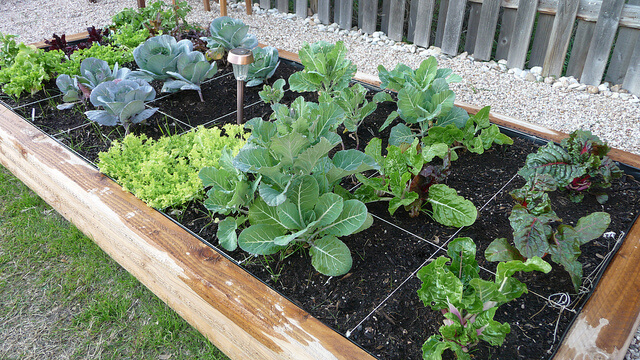
Source: https://flic.kr/p/8a1Sy2
- Types of small plants and the number that can be grown in a 4’x4’ SFG- 4 beans, 16 carrots, 9 onions, 9 beets, 16 peas, 32 leaf lettuces, 16 radishes, 9 turnips, 18 spinach, 9 parsnips, 16 Mesclun mix lettuce, 2 parsley and 2 thyme.
- Types of large plants and the number that can be grown in a 4’x4’ SFG- 1 cabbage, 1 broccoli, 1 cauliflower, 1 green pepper, 1 red pepper, 1 eggplant, 5 heads of lettuce, 2 hot peppers, 1 brussel sprout, 2 kale, 3 Bok Choi, 2 summer squash, 1 cherry tomato, 2 celery, 2 potatoes and 2 stalks of corn.
- Plants that require vertical support such as cucumbers, tomatoes and pole beans can also be grown in your garden.
The above group are just examples. The online guides I listed previously can help you in determining which other plants – small, large or vertical – can be grown in your SFG – and how to place their seeds. i.e. 16 seeds per square foot versus 4.
Watering
After you have planted the seeds, you need to water them regularly. If you want to go hi-tech, you can lay drip lines along your plants. Although this method will cost additional money, it can save you time and your plants lives-especially if you live in a hot and semi-arid climate.
When using a water can, make sure your water is at room temperature or slightly warmer, as this helps to warm the soil and promote growth.
Harvesting
After waiting a few weeks, you should have some mature plants which can be harvested. The great thing about a SFG is that you can harvest the plants continually with ease. For plants like potatoes, you can remove the plants, dig out any roots or debris, add new compost and then start all over again.
Maintaining Your Garden
To ensure that your plants grow healthy, water them regularly and also weed periodically. Presence of weeds means that your plants will compete for resources therefore leading to a decline in their health.
To keep pests away, you can leave some space to grow flowers like Dwarf sunflowers and French Marigolds. Additionally, onions, garlic and oregano help keep pests away.
The soil that you have used can be recycled over and over by adding mulch and compost to ensure the right nutrients are always present.
Malibu Compost Bu’s Brew Biodynamic Compost Tea Bags, 1 lb Garden Netting – Protects Against Birds, Deer and Other Pests-7.5′ x 65′
Garden Netting – Protects Against Birds, Deer and Other Pests-7.5′ x 65′
5 Tips to Ensure the Success of Your Garden
- Locate the garden near a convenient source of water. Doing this reduces the distance you have to travel in order to water them. You have several choices you can use to water your plants such as a water can or via a drip system.
- Provide fertile soil. Depending on where you live, you will need to use a certain type of soil in your SFG to allow your plants to grow. If you are not sure if the soil is fertile and can support your plants, have the soil tested by a professional or buy a kit. You can also add a layer of mulch or compost to provide the necessary nutrients for the plants.
- Keep the garden weeded. Even though you have a raised garden, it does not mean that weeds will not grow around your plants. You need to have periodic weeding sessions in order to ensure that your plants get to grow healthy.
- Select a sunny location. The rays of the sun allow plants to make their own food. This process is called photosynthesis. You need to locate your garden where the rays of the sun shine on your plants. Obstacles like tall trees should be minimal.
- Follow the instructions on the seed packet. Every seed packet you purchase comes with a set of instructions. Even if you have been a gardener for quite some time, I recommend you follow the instructions listed on the seed packet.
That wasn’t too bad, right? Almost anybody can plant a square foot garden. It does require a new viewpoint but once you got it down, you can definitely see the efficiency behind it. This concept is especially useful for us small space gardeners as we need to make the most effiicent use of our space!
